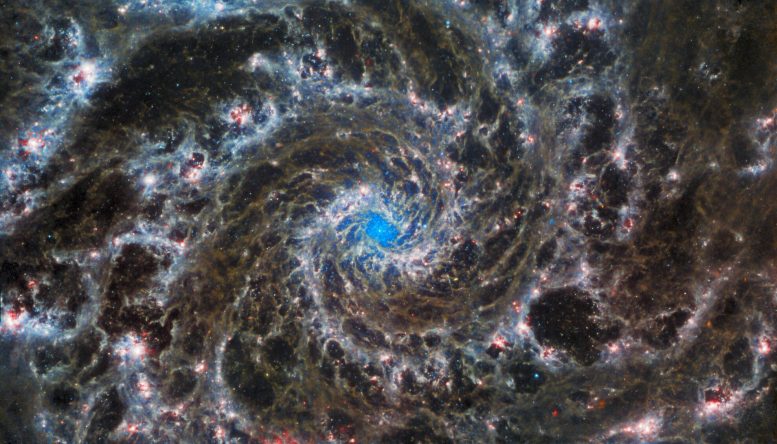
This image from the James Webb Space Telescope shows the heart of M74, otherwise known as the Phantom Galaxy. Webb’s sharp vision has revealed delicate filaments of gas and dust in the grandiose spiral arms which wind outwards from the center of this image. A lack of gas in the nuclear region also provides an unobscured view of the nuclear star cluster at the galaxy’s center. Credit: ESA/Webb, NASA & CSA, J. Lee and the PHANGS-JWST Team
Incredible new images of the spectacular Phantom Galaxy, M74, showcase the power of space observatories working together in multiple wavelengths. In this case, data from the James Webb Space Telescope and the Hubble Space Telescope complement each other to provide a comprehensive view of the galaxy.
The Phantom Galaxy is located approximately 32 million light-years away from Earth in the constellation Pisces. It lies almost face-on to Earth. This, coupled with its well-defined spiral arms, makes it a favorite target for astronomers studying the origin and structure of galactic spirals.
New images of the Phantom Galaxy, M74, showcase the power of space observatories working together in multiple wavelengths. This video includes the Hubble Space Telescope’s view of the galaxy, which showcases the older, redder stars towards the center, to younger and bluer stars in its spiral arms, to the most active stellar formation in the red bubbles of H II regions. The James Webb Space Telescope’s image is strikingly different, instead highlighting the masses of gas and dust within the galaxy’s arms, and the dense cluster of stars at its core. The combined image of M74 merges these two for a truly unique look at this “grand design” spiral galaxy.
M74 is a particular class of spiral galaxy known as a ‘grand design spiral.’ This means that its spiral arms are prominent and well-defined, unlike the patchy and ragged structure seen in some spiral galaxies.
Webb’s sharp vision has revealed delicate filaments of gas and dust in the grandiose spiral arms of M74, which wind outwards from the center of the image. A lack of gas in the nuclear region also provides an unobscured view of the nuclear star cluster at the galaxy’s center.
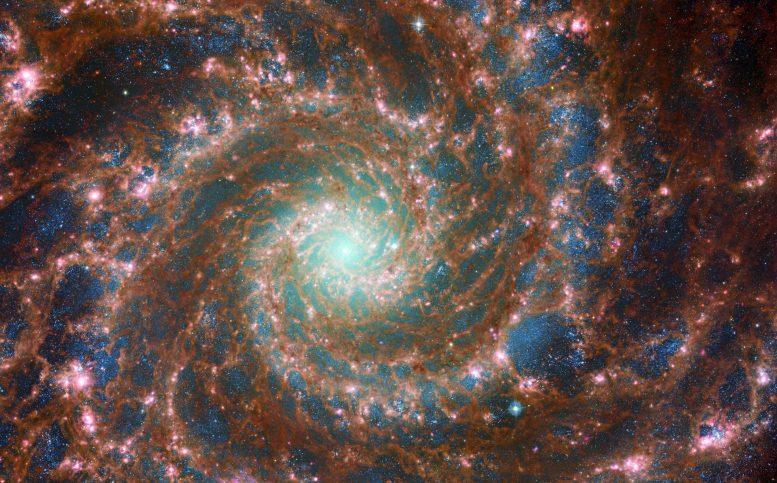
M74 shines at its brightest in this combined optical/mid-infrared image, featuring data from both the Hubble Space Telescope and the James Webb Space Telescope.
With Hubble’s venerable Advanced Camera for Surveys (ACS) and Webb’s powerful Mid-InfraRed Instrument (MIRI) capturing a range of wavelengths, this new image has remarkable depth. The red colors mark dust threaded through the arms of the galaxy, lighter oranges being areas of hotter dust. The young stars throughout the arms and the nuclear core are picked out in blue. Heavier, older stars towards the galaxy’s center are shown in cyan and green, projecting a spooky glow from the core of the Phantom Galaxy. Bubbles of star formation are also visible in pink across the arms. Such a variety of galactic features is rare to see in a single image.
Scientists combine data from telescopes operating across the electromagnetic spectrum to truly understand astronomical objects. In this way, data from Hubble and Webb complement each other to provide a comprehensive view of the spectacular M74 galaxy.
Credit: ESA/Webb, NASA & CSA, J. Lee and the PHANGS-JWST Team; ESA/Hubble & NASA, R. Chandar Acknowledgement: J. Schmidt
Webb peered into M74 using its Mid-InfraRed Instrument (MIRI) in order to learn more about the earliest phases of star formation in the local Universe. These observations are part of a larger effort to chart 19 nearby star-forming galaxies in the infrared by the international PHANGS collaboration. Those galaxies have already been observed using the Hubble Space Telescope and ground-based observatories.
The addition of crystal-clear Webb observations at longer wavelengths will enable astronomers to pinpoint star-forming regions in the galaxies, accurately measure the masses and ages of star clusters, and gain insights into the nature of the small grains of dust drifting in interstellar space.
This image from the James Webb Space Telescope shows the heart of M74, otherwise known as the Phantom Galaxy. Webb’s sharp vision has revealed delicate filaments of gas and dust in the grandiose spiral arms which wind outwards from the center of this image. A lack of gas in the nuclear region also provides an unobscured view of the nuclear star cluster at the galaxy’s center. M74 is a particular class of spiral galaxy known as a ‘grand design spiral’, meaning that its spiral arms are prominent and well-defined, unlike the patchy and ragged structure seen in some spiral galaxies.
Hubble observations of M74 have revealed particularly bright areas of star formation known as HII regions. Hubble’s sharp vision at ultraviolet and visible wavelengths complements Webb’s unparalleled sensitivity at infrared wavelengths, as do observations from ground-based radio telescopes such as the Atacama Large Millimeter/submillimeter Array, ALMA.
By combining data from telescopes operating across the electromagnetic spectrum, scientists can gain greater insight into astronomical objects than by using a single observatory – even one as powerful as Webb!
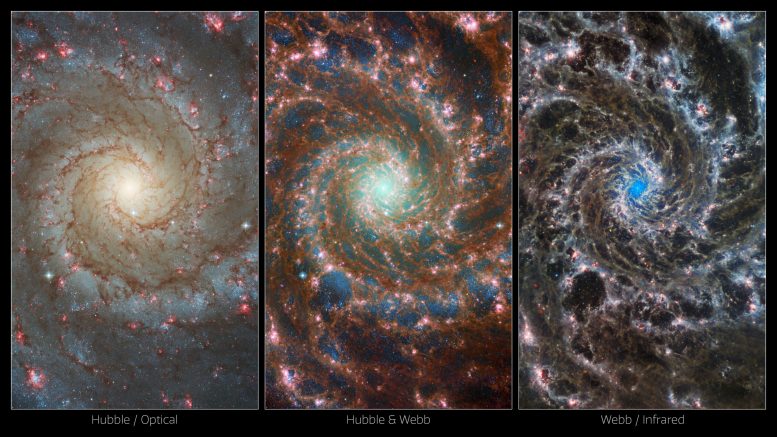
New images of the Phantom Galaxy, M74, showcase the power of space observatories working together in multiple wavelengths.
On the left, the Hubble Space Telescope’s view of the galaxy ranges from the older, redder stars towards the center, to younger and bluer stars in its spiral arms, to the most active stellar formation in the red bubbles of H II regions. On the right, the James Webb Space Telescope’s image is strikingly different, instead highlighting the masses of gas and dust within the galaxy’s arms, and the dense cluster of stars at its core. The combined image in the center merges these two for a truly unique look at this “grand design” spiral galaxy.
Credit: ESA/Webb, NASA & CSA, J. Lee and the PHANGS-JWST Team; ESA/Hubble & NASA, R. Chandar Acknowledgement: J. Schmidt
About Webb
The James Webb Space Telescope is the world’s premier space science observatory. Webb will solve mysteries in our Solar System, look beyond to distant worlds around other stars, and probe the mysterious structures and origins of our Universe and our place in it. Webb is an international program led by NASA with its partners, ESA and the Canadian Space Agency. The major contributions of ESA to the mission are: the NIRSpec instrument; the MIRI instrument optical bench assembly; the provision of the launch services; and personnel to support mission operations. In return for these contributions, European scientists will get a minimum share of 15% of the total observing time, like for the Hubble Space Telescope.
M74 shines at its brightest in this combined optical/mid-infrared image, featuring data from both the Hubble Space Telescope and the James Webb Space Telescope. With Hubble’s venerable Advanced Camera for Surveys (ACS) and Webb’s powerful Mid-InfraRed Instrument (MIRI) capturing a range of wavelengths, this new image has remarkable depth. The red colors mark dust threaded through the arms of the galaxy, lighter oranges being areas of hotter dust. The young stars throughout the arms and the nuclear core are picked out in blue. Heavier, older stars towards the galaxy’s center are shown in cyan and green, projecting a spooky glow from the core of the Phantom Galaxy. Bubbles of star formation are also visible in pink across the arms. Such a variety of galactic features is rare to see in a single image.
MIRI was contributed by ESA and NASA, with the instrument designed and built by a consortium of nationally funded European Institutes (the MIRI European Consortium) in partnership with JPL and the University of Arizona.

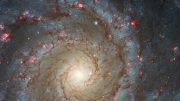

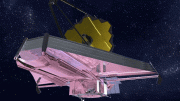

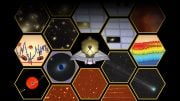
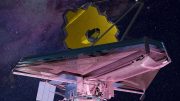
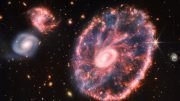
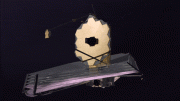
Does this remind you of the Mandelbrot set?
Me too. Second thing I thought – first thing was “Holy s***! Is that real?”
The Webb is really delivering.
Hmm. Don’t you get it, yet? The organization, beauty, and the other factors for which there is no explanation? The creation of all good things? Who can possibly deny the Creator? Amen!
Hmm. Don’t you get it, yet? We don’t need a figment of the imagination to explain what we see – well, most of us don’t.
well if you guy,s keep looking mybe you can find a planet that has dinosurs then we can beam up sum unwanted people